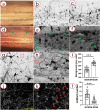A combinatorial method to visualize the neuronal network in the mouse spinal cord: combination of a modified Golgi-Cox method and synchrotron radiation micro-computed tomography
- PMID: 33398435
- PMCID: PMC8062354
- DOI: 10.1007/s00418-020-01949-8
A combinatorial method to visualize the neuronal network in the mouse spinal cord: combination of a modified Golgi-Cox method and synchrotron radiation micro-computed tomography
Abstract
Exploring the three-dimensional (3D) morphology of neurons is essential to understanding spinal cord function and associated diseases comprehensively. However, 3D imaging of the neuronal network in the broad region of the spinal cord at cellular resolution remains a challenge in the field of neuroscience. In this study, to obtain high-resolution 3D imaging of a detailed neuronal network in the mass of the spinal cord, the combination of synchrotron radiation micro-computed tomography (SRμCT) and the Golgi-cox staining were used. We optimized the Golgi-Cox method (GCM) and developed a modified GCM (M-GCM), which improved background staining, reduced the number of artefacts, and diminished the impact of incomplete vasculature compared to the current GCM. Moreover, we achieved high-resolution 3D imaging of the detailed neuronal network in the spinal cord through the combination of SRμCT and M-GCM. Our results showed that the M-GCM increased the contrast between the neuronal structure and its surrounding extracellular matrix. Compared to the GCM, the M-GCM also diminished the impact of the artefacts and incomplete vasculature on the 3D image. Additionally, the 3D neuronal architecture was successfully quantified using a combination of SRμCT and M-GCM. The SRμCT was shown to be a valuable non-destructive tool for 3D visualization of the neuronal network in the broad 3D region of the spinal cord. Such a combinatorial method will, therefore, transform the presentation of Golgi staining from 2 to 3D, providing significant improvements in the 3D rendering of the neuronal network.
Keywords: Modified Golgi-Cox method; Neuronal network; SRμCT; Spinal cord; Three-dimension.
Conflict of interest statement
The authors declare no conflict of interest.
Figures








Similar articles
-
3D visualization and morphometric analysis of spinal motion segments and vascular networks: A synchrotron radiation-based micro-CT study in mice.J Anat. 2022 Feb;240(2):268-278. doi: 10.1111/joa.13556. Epub 2021 Oct 7. J Anat. 2022. PMID: 34622448 Free PMC article.
-
Simultaneous 3D Visualization of the Microvascular and Neural Network in Mouse Spinal Cord Using Synchrotron Radiation Micro-Computed Tomography.Neurosci Bull. 2021 Oct;37(10):1469-1480. doi: 10.1007/s12264-021-00715-7. Epub 2021 Jun 19. Neurosci Bull. 2021. PMID: 34146232 Free PMC article.
-
Comparison of Synchrotron Radiation-based Propagation Phase Contrast Imaging and Conventional Micro-computed Tomography for Assessing Intervertebral Discs and Endplates in a Murine Model.Spine (Phila Pa 1976). 2017 Aug 1;42(15):E883-E889. doi: 10.1097/BRS.0000000000002110. Spine (Phila Pa 1976). 2017. PMID: 28187077
-
Synchrotron radiation micro-tomography for high-resolution neurovascular network morphology investigation.J Synchrotron Radiat. 2019 May 1;26(Pt 3):607-618. doi: 10.1107/S1600577519003060. Epub 2019 Apr 15. J Synchrotron Radiat. 2019. PMID: 31074423 Review.
-
Quantitative and qualitative bone imaging: A review of synchrotron radiation microtomography analysis in bone research.J Mech Behav Biomed Mater. 2020 Oct;110:103887. doi: 10.1016/j.jmbbm.2020.103887. Epub 2020 Jun 25. J Mech Behav Biomed Mater. 2020. PMID: 32957194 Review.
Cited by
-
In focus in HCB.Histochem Cell Biol. 2021 Apr;155(4):435-438. doi: 10.1007/s00418-021-01986-x. Epub 2021 Apr 13. Histochem Cell Biol. 2021. PMID: 33846859 No abstract available.
-
3D visualization and morphometric analysis of spinal motion segments and vascular networks: A synchrotron radiation-based micro-CT study in mice.J Anat. 2022 Feb;240(2):268-278. doi: 10.1111/joa.13556. Epub 2021 Oct 7. J Anat. 2022. PMID: 34622448 Free PMC article.
-
Bone Marrow Mesenchymal Stem Cell-Derived Exosome-Educated Macrophages Promote Functional Healing After Spinal Cord Injury.Front Cell Neurosci. 2021 Sep 28;15:725573. doi: 10.3389/fncel.2021.725573. eCollection 2021. Front Cell Neurosci. 2021. PMID: 34650405 Free PMC article.
References
-
- Cedola A, Bravin A, Bukreeva I, Fratini M, Pacureanu A, Mittone A, Massimi L, Cloetens P, Coan P, Campi G, Spano R, Brun F, Grigoryev V, Petrosino V, Venturi C, Mastrogiacomo M, Kerlero de Rosbo N, Uccelli A. X-ray phase contrast tomography reveals early vascular alterations and neuronal loss in a multiple sclerosis model. Sci Rep. 2017;7(1):5890. doi: 10.1038/s41598-017-06251-7. - DOI - PMC - PubMed
MeSH terms
Grants and funding
LinkOut - more resources
Full Text Sources
Other Literature Sources

